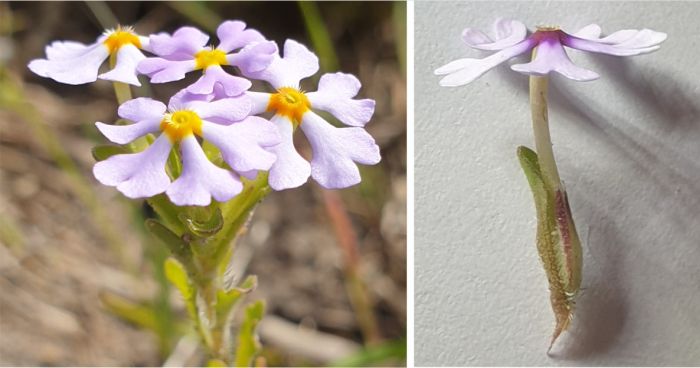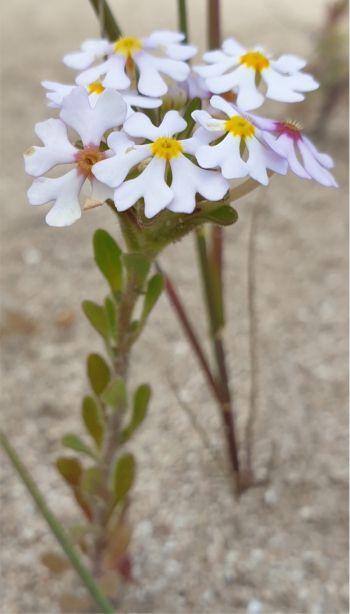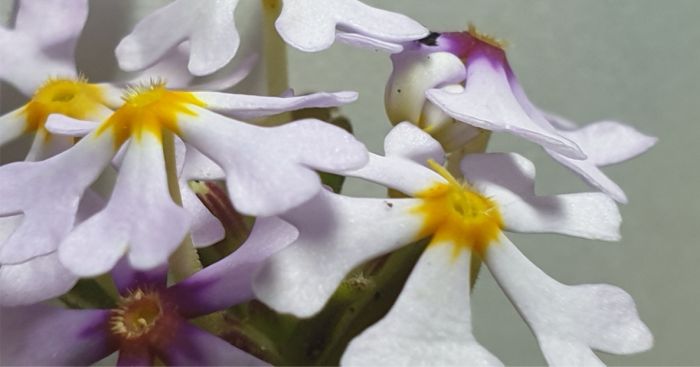Zaluzianskya villosa
Zaluzianskya villosa F.W.Schmidt
Family: Scrophulariaceae
Common names: downy drumsticks (Eng.); verfblommetjie (Afr.)
Introduction
These small, dainty, white to mauve flowered annuals can be seen in spring and early summer in the Western Cape of South Africa. Unlike Zaluzianskya capensis, the flowers of Z. villosa do not have a strong perfume, but when seen growing en masse, one quickly realizes how incredibly beautiful and special this little annual is.

Description
Description
Zaluzianskya villosa is an annual, growing to a height of 60-300 mm. It branches from the base and the branches lie flat or curve upwards. The stems have hairs that point backwards (retrorse) and the leaves, are also hairy. The leaves are spathulate or obovate. They have short petioles or may be sessile. The inflorescence is a compact spike consisting of many flowers, that occurs above the leaves and terminates apical growth. The bracts are longer than the calyx and the calyx is shortly 2-lipped and hairy. The flower tubes are 10-25 mm long. The throat of the tube is fringed with hairs and is minutely glandular outside. Zaluzianskya villosa has only 2 stamens. The flowers are white to mauve with a yellow or red star in the centre and the flower lobes are deeply forked. Flowers appear from midwinter to early summer (July to November).

Conservation Status
Status
Zaluzianskya villosa is assessed as Least Concern (LC) on the Red list of South African Plants.
Distribution and habitat
Distribution description
Zaluzianskya villosa is commonly seen growing in the Western Cape of South Africa, from Langebaan to Pearly Beach, on sandy flats along the coast. It also occurs inland, from Namaqualand to the Overberg and in the Karoo. It is found growing in full sun to semi-shade and experiences cold wet winters and hot dry summers. During summer, it can experience day temperatures of up to 30ᵒC and 15ᵒC at night. In winter, day temperatures can be lower than 15ᵒC while night temperatures can be as low as 5ᵒC.

Derivation of name and historical aspects
History
The genus Zaluzianskya was named after Adam Zalusiansky von Zaluzian (1558-1613). He was a Bohemian physician and a botanist, and a lecturer and an administrator at Charles University in Prague. He authored the Methodus Herbariae Libri Tres in 1592. He was the first to argue for the separation of botany from medicine, and for a universal classification of plants, years before Linnaeus. The species name villosa is derived from the Latin villus, which means ‘hair’ and -osus meaning ‘full of’, thus villosus means ‘full of shaggy hairs’ or ‘shaggy’ and refers to a covering of shaggy hair.
The genus Zaluzianskya belongs to the figwort family Scrophulariaceae, which is one of 26 families in the order Lamiales. It contains around 65 genera and 1 700 species, which are distributed all over the world. Other noteworthy genera in this family are Diascia, Nemesia and Buddleja. There are over 50 species of Zaluzianskya in southern Africa. The annuals are mostly found in the Western Cape, while the perennials are found in the summer-rainfall areas of eastern southern Africa.

Ecology
Ecology
The long-tubed, evening scented flowers of some species of Zaluzianskya are specialized for pollination by hawkmoths (Sphingidae), predominantly Hippotion celerio. However, Zaluzianskya villosa flowers are open during the day (diurnal) and lack scent, and are pollinated by long proboscid bee-flies (Bombyliidae), which have been observed visiting the flowers (John Manning, personal communication, 27 October 2023). It is also interesting to note that the yellow star in the centre of the flower changes to pink after pollination, which is possibly a signal to pollinators that nectar is no longer available.
Uses
Use
There are no crop plants in the family Scrophulariaceae, however, many of the plants are used as ornamentals in home gardens. Others are considered weeds such the mullein (Verbascum). As for Zaluzianskya villosa, there are no known uses.

Growing Zaluzianskya villosa
Grow
As Zaluzianskya villosa is an annual, it needs to be grown from seed. It can be treated as a spring annual where it seeds are sown in autumn (April-May).
Sow seeds either where they are intended to grow or, in trays or beds and transplant the seedlings into the garden when large enough. Sow seeds into a mixture of 50% sieved milled bark and 50% river sand. Lightly compact the mixture in the seed trays and sow the seeds evenly. Cover the seed with a thin layer of river sand. Water the trays lightly every second day, using a fine rose nozzle. Seeds should take between 4 and 8 weeks to germinate. Prick the seedlings out as soon as they are large enough to handle, and transplant them into a sunny bed, in well-drained, composted sandy soil.
Zaluzianskya villosa flowers are small, however when grown en masse, they put on a great floral display. They have the potential to make beautiful border displays or to be grown in rockeries.
References
- Adamson, R.S. & Salter, T.H (eds). 1950. Flora of the Cape Peninsula. Juta, Cape Town.
- Burman, l. & Bean, A. 1985. Hottentots Hollands to Hermanus. South African Wild Flower Guide 5. Botanical Society of South Africa, Cape Town.
- Casabio The Home of Biodiversity. Species Zaluzianskya villosa. https://casabio.org/taxa/zaluzianskya-villosa. Accessed 24 November 2023.
- Goldblatt, P. & Manning, J. 2000. Cape Plants. A conspectus of the Cape flora of South Africa. Strelitzia 9. National Botanical Institute, Pretoria & Missouri Botanical Garden, Missouri.
- Mathebula, X. & Manning, J. 2012. Zaluzianskya microsiphon (O.Kuntze) K.Schum. (Scrophulariaceae). PlantZAfrica. Online. http://pza.sanbi.org/zaluzianskya-microsiphon.
- Pooley, E. 2003. Mountain flowers, a field guide to the flora of the Drakensberg and Lesotho. Natal Flora Publications Trust, Durban.
- Powrie, F. 1998. Grow South African Plants. A gardener's companion to indigenous plants. National Botanical Institute, Cape Town.
- Raimondo, D., Von Staden, L., Foden, W., Victor, J.E., Helme, N.A., Turner, R.C., Kamundi, D.A. & Manyama, P.A. (eds) 2009. Red list of South African plants. Strelitzia 25. South African National Biodiversity Institute, Pretoria.
- Stearn, W.T. 1992. Stearn’s Dictionary of Plant Names for gardeners. A handbook on the origin and meaning of the botanical names of some cultivated plants. Cassell, UK.
- Usher, G. 1966. A Dictionary of Botany. Constable, London.
Credits
Karen Wall
Kirstenbosch National Botanical Garden
December 2023
Plant Attributes:
Plant Type: Bi/Annual
SA Distribution: Western Cape
Soil type: Sandy
Flowering season: Spring, Early Summer, Winter
PH: Acid
Flower colour: White, Yellow, Mauve/Lilac
Aspect: Full Sun
Gardening skill: Average
Special Features:
Horticultural zones







Rate this article
Article well written and informative
Rate this plant
Is this an interesting plant?
Login to add your Comment
Back to topNot registered yet? Click here to register.